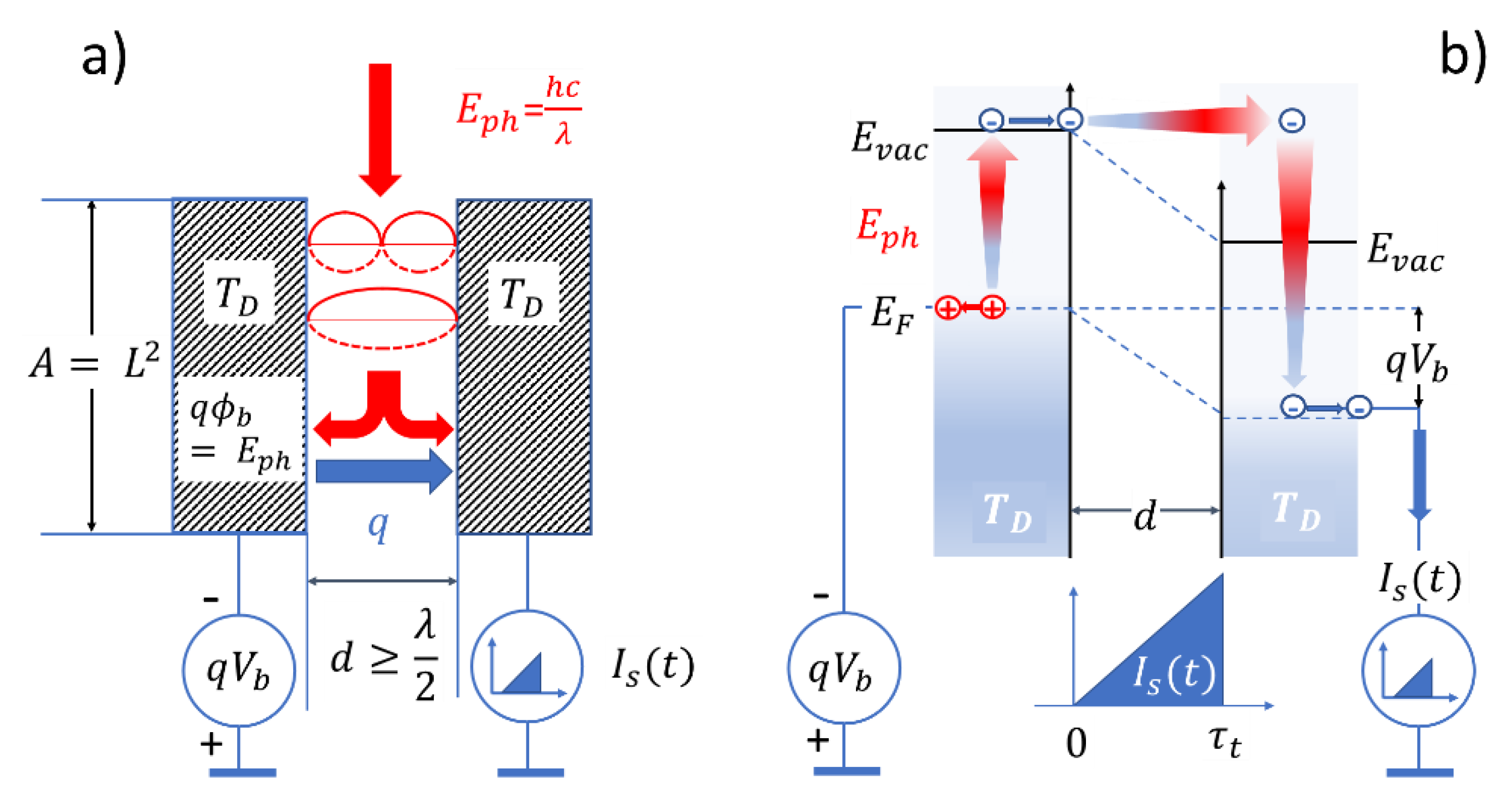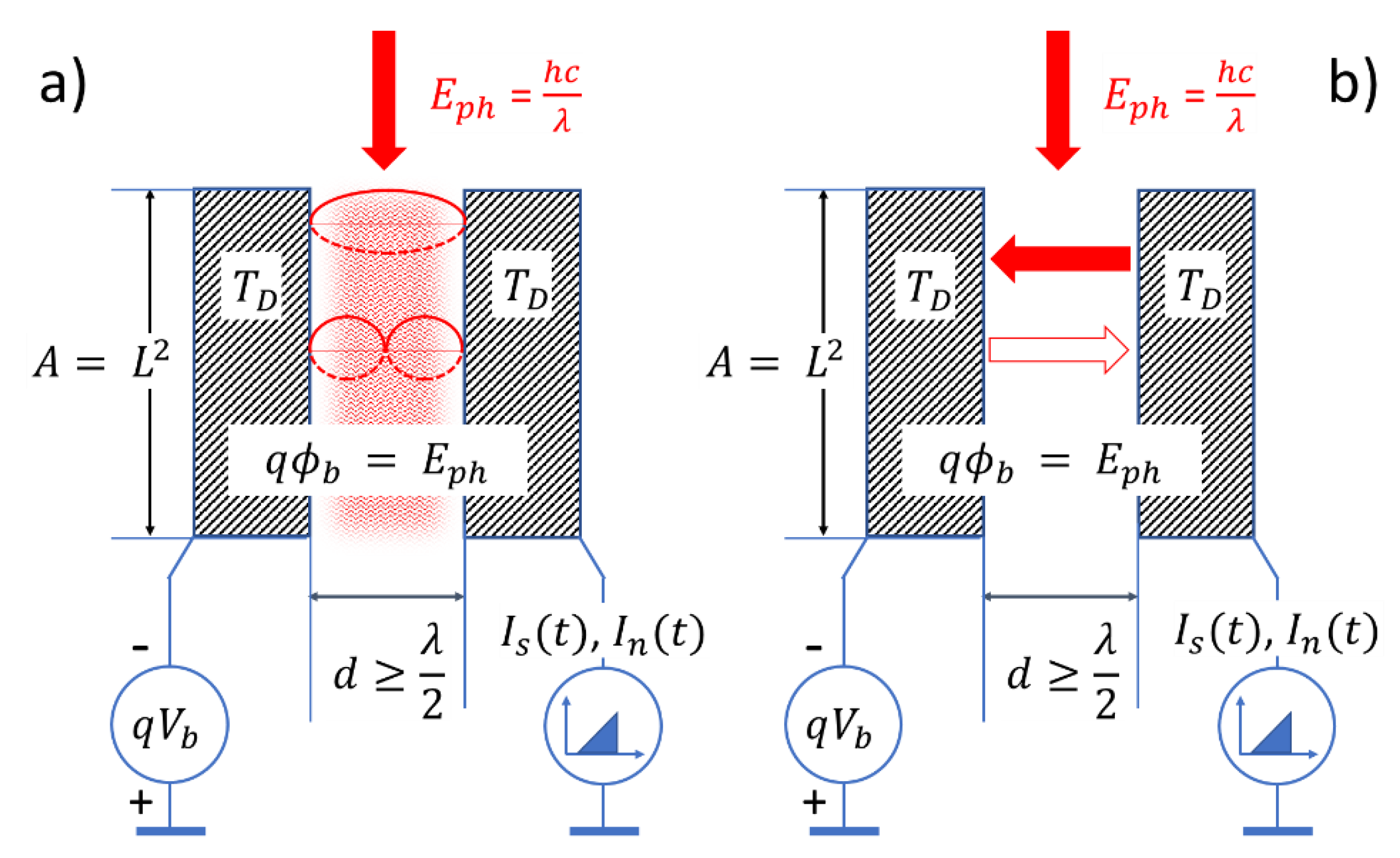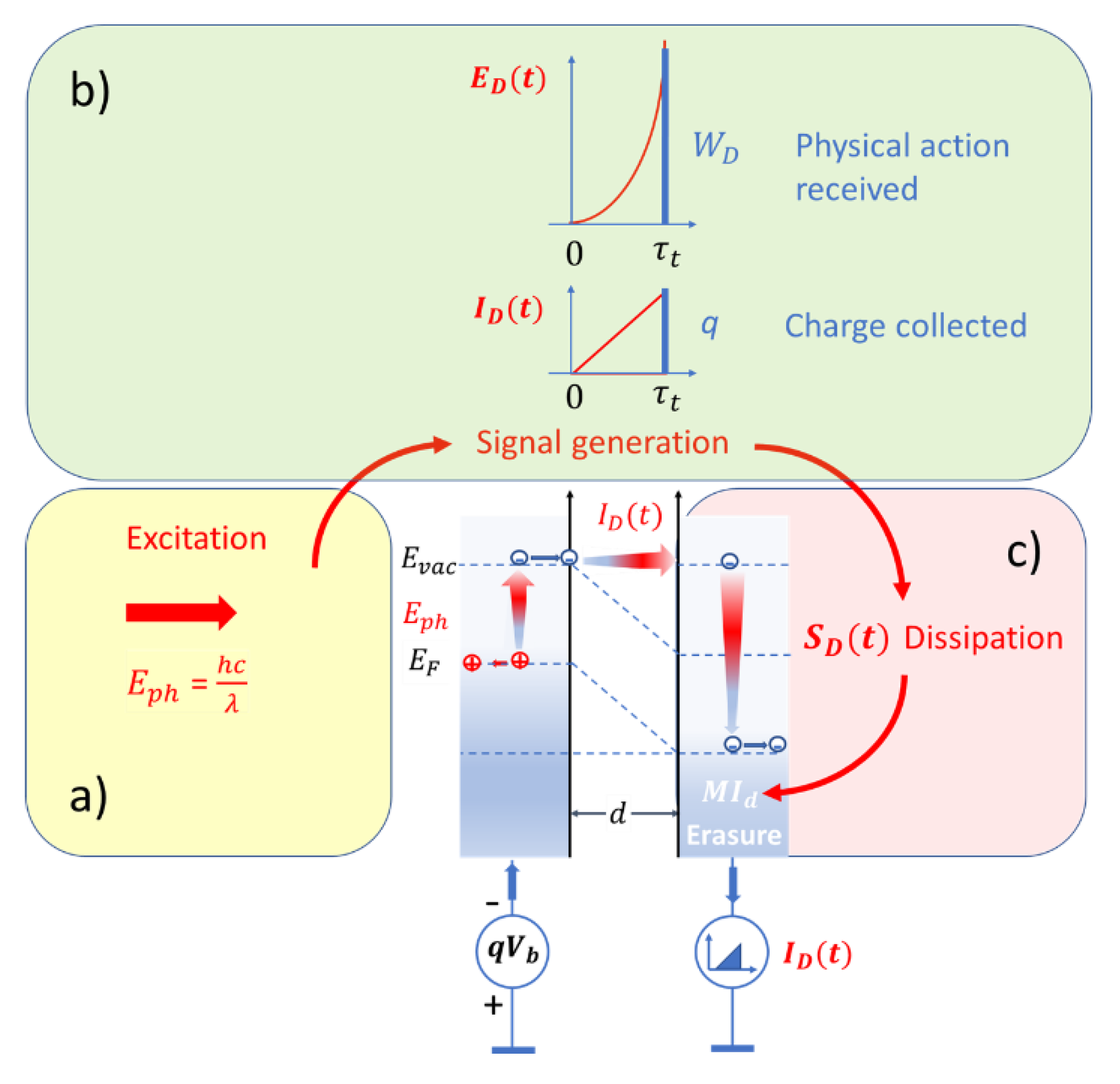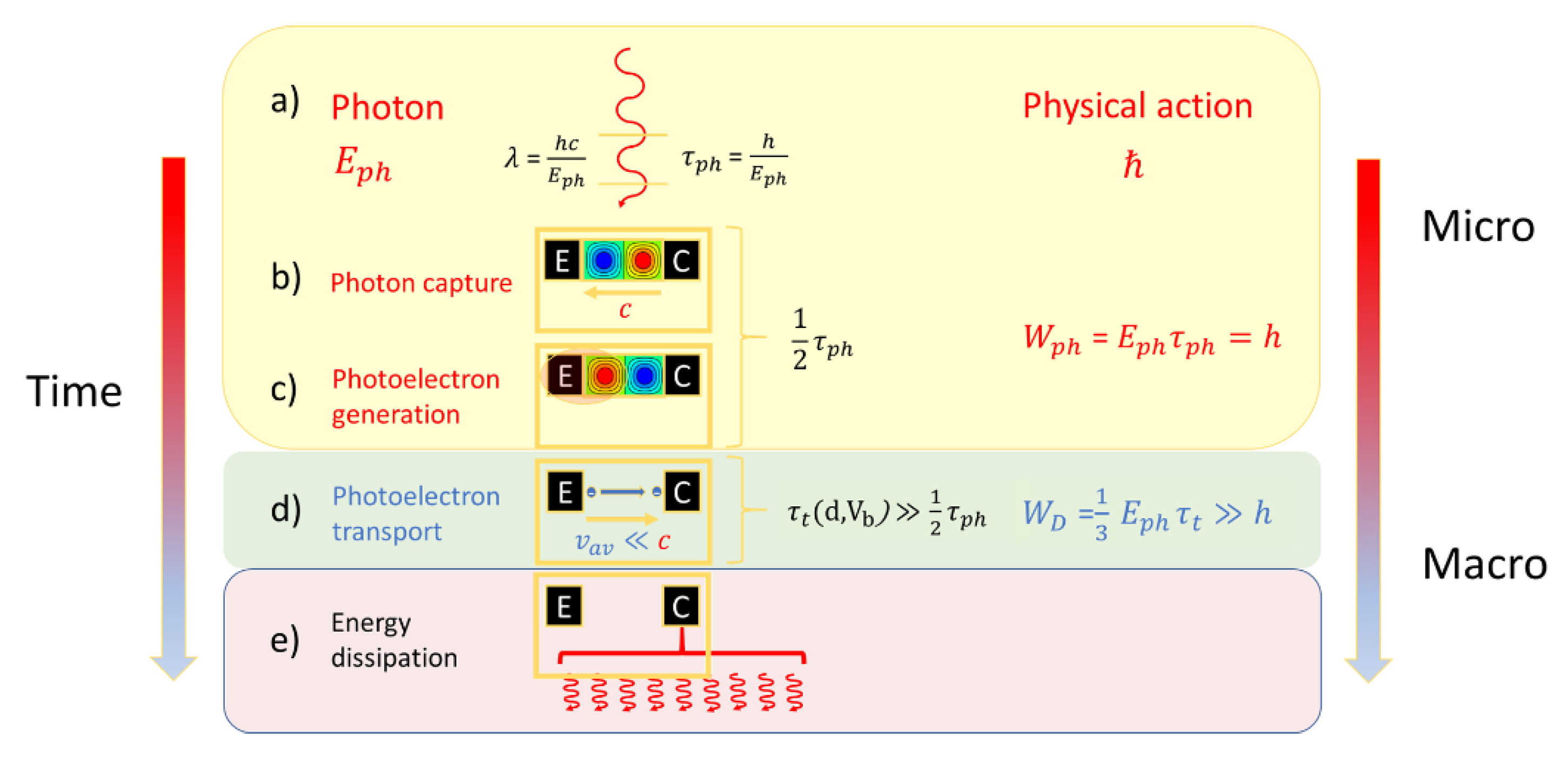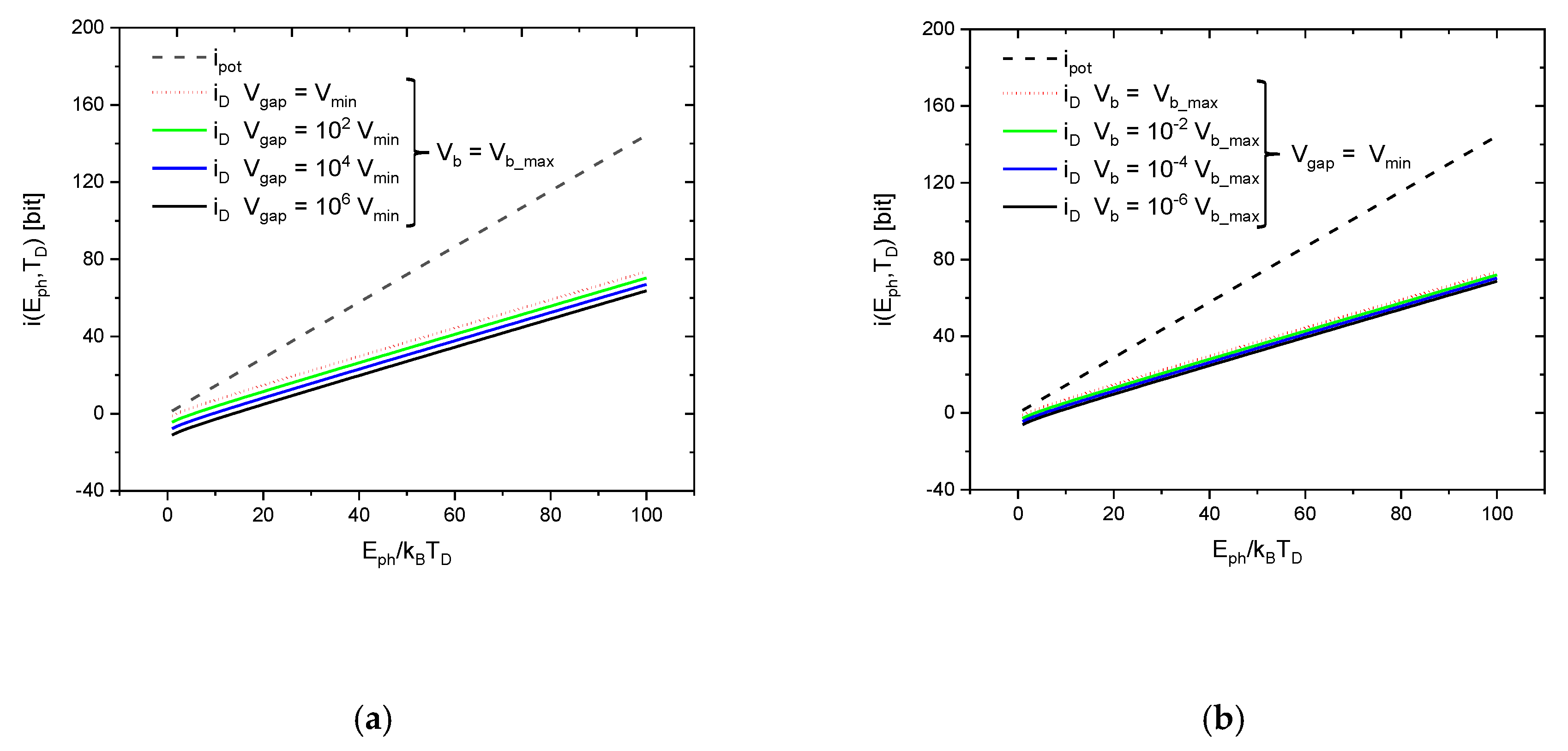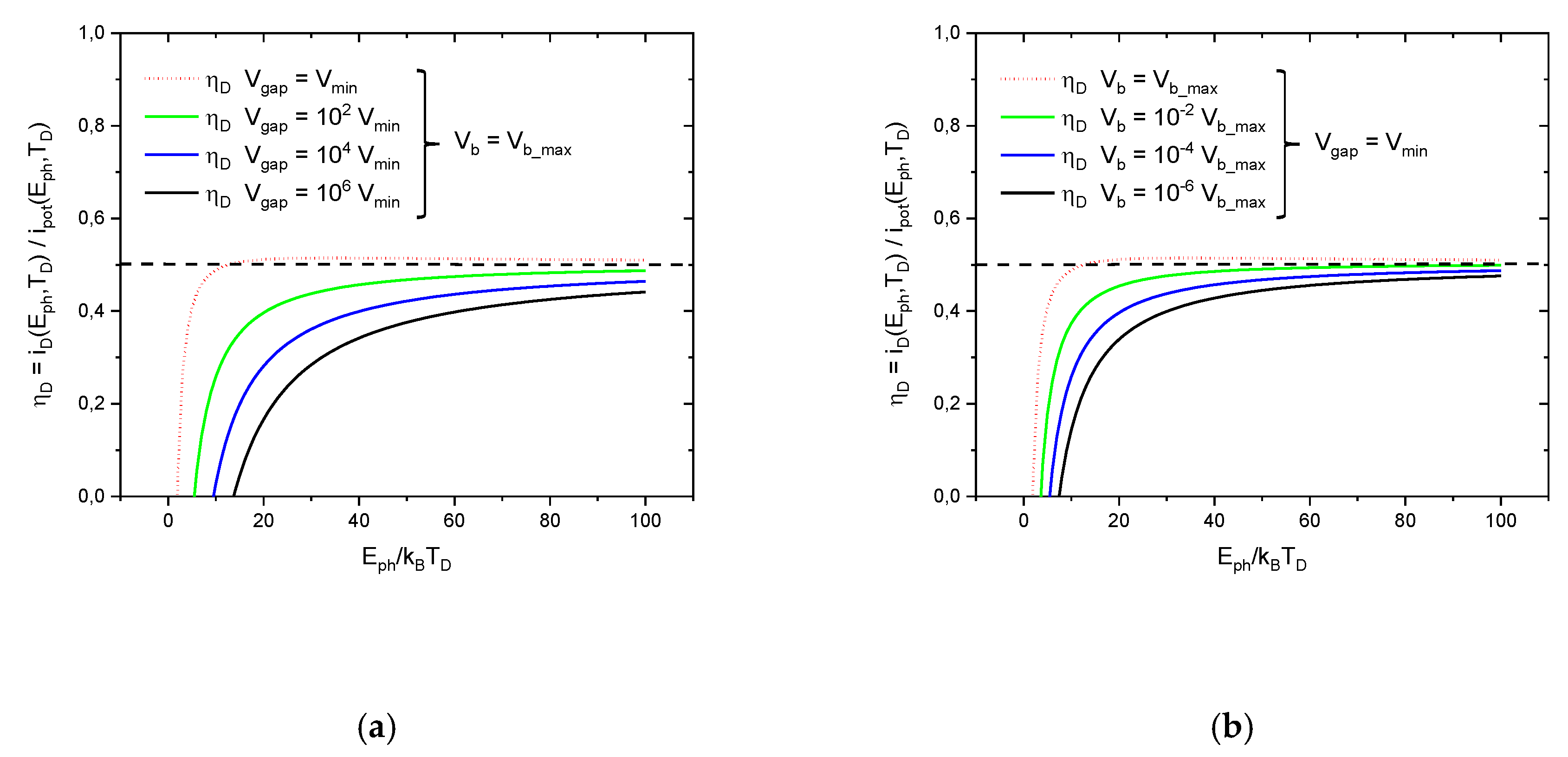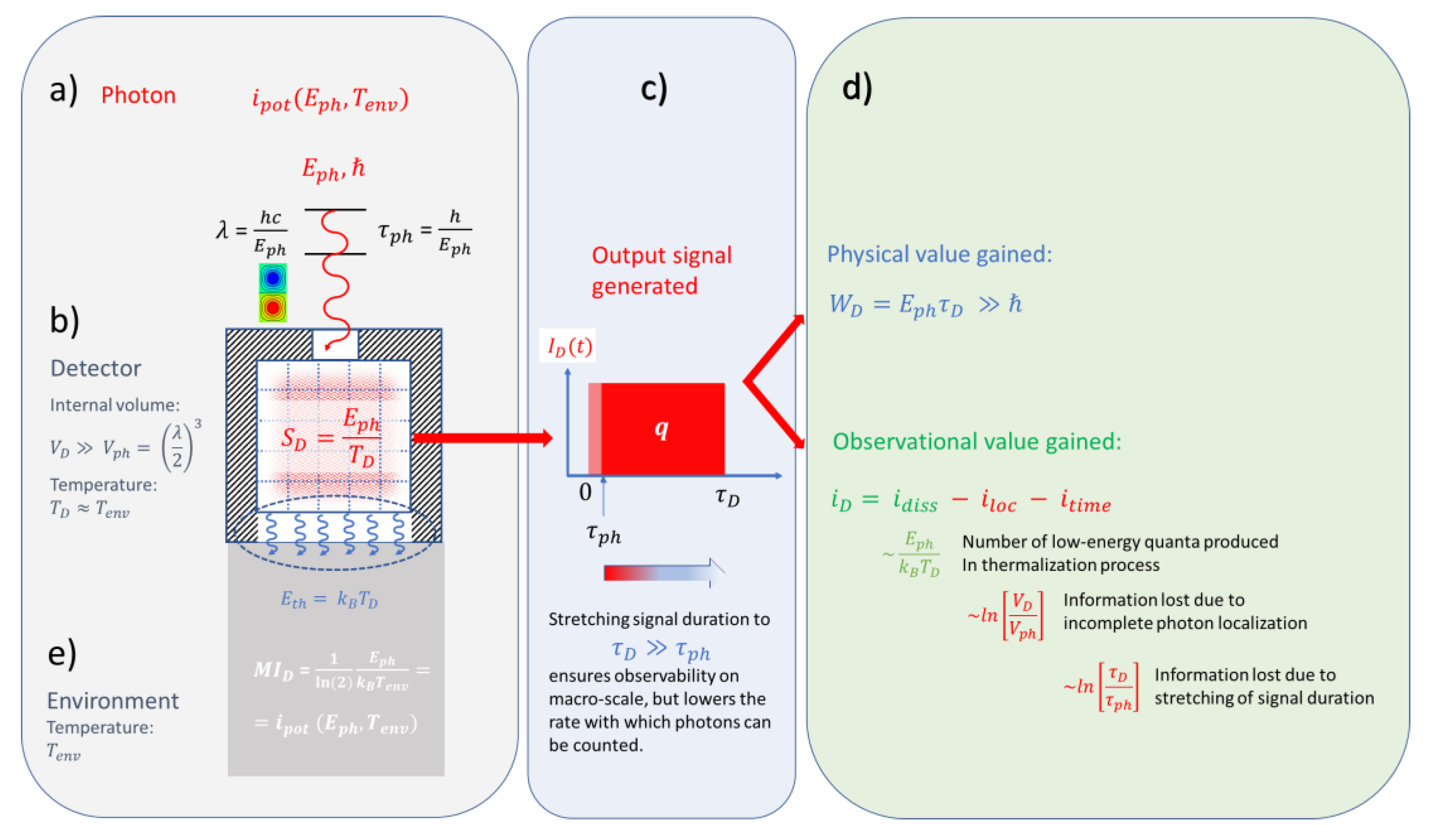So far, we have been considering the standard theory of PID detectors as described in the textbook of Kingston [
20]. As already stated in the introduction, this theory successfully satisfies all engineering demands concerned with the development and use of such photon detectors. This standard theory, however, completely disregards the concept of “information” and it remains vague concerning the concept of “detection events”. In the following, both conceptual vehicles are discussed and introduced into the theory as physically measurable quantities.
4.1. Detection Events and Entropic Cost
As described above, triangular current pulses of the form
form the observational images of photon–detector interactions. As it does not matter whether these pulses had been caused by true photon–detector interactions, i.e., by signal photons, or by internally generated noise photons, we use the more general index
, here. Both kinds of current transients constitute detection events, however, with a limited observational value as by simple observation it does not become clear whether an observed event has been a signal or a noise event.
In addition to time-dependent functions like Equation (18), such current transients can also be characterized in an integral, per-event manner by evaluating integrals over the entire pulse duration. A first and obvious opportunity is integrating the current transient over the time interval to determine the total collected charge. In case this charge happens to coincide with the elementary charge , evidence is provided that a single photon has been detected.
Further integral quantities that can be derived from such single-electron transits can be obtained by multiplying the current pulses
with the bias potential
through which the photoelectrons had fallen during their transit through the detector gap. In this way the signal power
is obtained. Double integration over time then successively leads to the signal energy
, the physical action
and finally the physical action
, received upon termination of the current pulse:
In addition to the kinetic energy
that the photoelectron had gained during its transit through the detector gap, the produced physical action also depends on the time
that the electron transit has taken. As, depending on the operational parameters
and
, the transit time can become orders of magnitude larger than the photon vibrational period
, this elongation effect is instrumental in turning microscopic photon detector interactions into macroscopically observable events. In receiving the associated piece of physical action,
, a price had to be paid. This price, obviously, consisted in the dissipation of the energy that the photoelectron had gained during its transit through the detector gap:
During dissipation the kinetic energy of the photoelectron is broken down into
pieces of energy of size
, which due to the thermal coupling of the PID to the environment, ultimately end up in the environment creating an entropy
there. As the environment represents a thermal reservoir of effectively infinite size, this entropy is added to the reservoir’s entropy without producing any measurable increase in temperature. In this way, the produced entropy is turned into a piece of missing information
concerning the internal state of motion within this huge reservoir. Once this has happened, the detection device has been reset to its pre-detection state which readied it for a new round of photon detection. For clarity, this process of turning photon energy into macroscopically observable events, i.e., pieces of physical action at the expense of energy dissipation, is illustrated in
Figure 3.
A special situation arises when the bias potential
is chosen to match the photon energy that had initially been invested to generate the photoelectron, i.e.,
. In this case the photon energy is converted in a one-to-one manner into the kinetic energy of a photoelectron and the entropy finally created is the same as if the photon had become directly absorbed in the huge environmental reservoir without producing any macroscopically observable effect at all. Further reducing the detector gap width to its physical minimum, the gain in physical action is:
and its entropic cost:
Realizing that
, even in this case, it is revealed that detection involves a fair bit of amplification as the produced physical action considerably overwhelms the physical action that had initially been carried with the photon prior to its detection in the form of its spin angular momentum. As already discussed above, such amplification is necessary to turn a microscopic event—the photon detector interaction—into a macroscopically observable event, i.e., into a current transient. The sketch of
Figure 4 tries to visualize this gain process, considering the capture of a photon in a narrow detector gap of size
and its conversion into a photoelectron which moves with a much lower speed than the photon through the gap, thus stretching out the detection event onto a macroscopically observable time scale.
4.2. Observational Value of Detection Events
As discussed in
Section 2 and
Section 3, the observation of a detection event does not uniquely prove that a true photon–detector interaction had taken place. Any observed event therefore is burdened with a limited observational value. In the standard theory this value is measured through the signal-to-noise ratio and other FOMs which build on this central figure of merit [
20].
Information as a physically measurable quantity can be introduced into the established theory of detector response simply by using
Applying this definition to Equation (17), the information gain upon detection
is seen to consist of three contributions:
The first of these,
measures the number of energy quanta of size
that can be generated upon dissipation of the photon energy
inside a detector operated at a temperature
. In the limit of large photon energies this approximates as
which corresponds to half the potential information that had initially been carried with the photon itself.
The second contribution adds with a negative sign and measures the information that had been lost due to the incomplete localization of the photon inside the detector gap:
The third term also adds with a negative sign, as after conversion of the photon into a photoelectron, the photoelectron moves with an average speed,
, much lower than the speed of light through the detector gap:
Figure 5 displays the variation of
of this technically realizable information gain in quantitative detail as a function of the reduced photon energy
for different parameter settings of
and
. This first set of results shows that the values of
never exceed the value of
, which in Equation (1) has been proposed to be an intrinsic information content that is carried with the photons themselves before any photon–detector interaction takes place.
Figure 6 displays this same result in a slightly different way, namely as a ratio of realized information gained and information intrinsically carried with the photons themselves.
This latter FOM more clearly shows that the realized information hardly ever exceeds a level of relative to the information that has intrinsically been carried with the photons themselves. The parameter measures the detector performance on a simple percentage basis relative to the performance of a hypothetical detector that can fully reveal the potential information carried by the photons themselves. Consequently, the parameter may be taken as a measure for the observational value that is associated with a detection event that had been generated under the parameter settings listed in the function .
In the
Appendix A it is shown that the FOM of detection efficiency (Equation (29)) maps onto the more commonly used FOM of specific detectivity
of ideal photon detectors, as described in the textbook of R.H. Kingston [
20]. As this detectivity represents an upper limit for the values of
that are technologically achievable with other kinds of photon detectors, the results of
Figure 5 and
Figure 6 are of a more general value, extending beyond the PIDs considered above. These results, therefore, support the point of view that the information
does indeed represent an intrinsic level of information that is carried with photons of energy
themselves prior to undergoing a detection process in a detector operated at a temperature
. Specifically,
Figure 6 reveals that, in agreement with Equation (2), this intrinsic information can only partially be recovered as realized information in a technical device:
As both realized and potential information are entropies which result from the dissipation of photon energy, this latter equation proves that the process of information gain is inherently irreversible.
Equation (30), in particular, shows that gaining a single bit of realized information minimally requires an input in photon energy of
units of energy. Such an energy cost of information has originally been proposed by Brillouin [
8] to represent the minimum energy cost that needs to be paid for gaining one bit of information. Landauer, later argued that this same amount of energy needs to be expended for erasing one bit of stored information [
9]. As detection events, i.e., pieces of realized information, are of a transient nature with lifetimes corresponding to the detector response time, such transients are somewhat self-erasing. Consequently, the energy invested in the generation of the information
is immediately turned into missing information as the photon energy is dissipated inside the detector and thereby ultimately lost. It therefore appears that in photon detection, the Brillouin and Landauer limits for information gain and information erasure map onto each other, producing the same predictions for the per-bit energy costs of information gain and information erasure.
